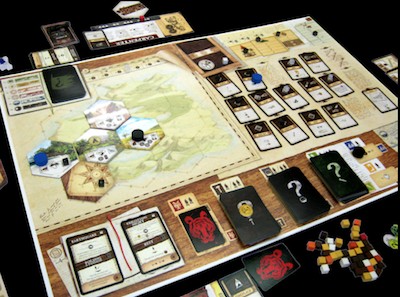The game under discussion today is one of the best we’ve ever covered here on Tabletop Co-Op. It was released in 2012, and has been getting rave reviews ever since. The game has been hard to find until very recently, and I was gleefully able to pick up my copy a few weeks ago. Robinson Crusoe: Adventure on the Cursed Island is both highly thematic and elegantly designed, and is an immersive, fully cooperative experience that board game fans don’t want to miss.
Generally speaking, there are two types of board games. One type, commonly known as “Euro style”, emphasize strategy, indirect conflict, and a low level of randomness. The second type, not-so-affectionately called “Ameritrash”, are generally more tactical, with direct player conflict and lots of randomness. Euros are typically light on theme, while Ameritrash games are dripping with it. Of the games we’ve discussed on Tabletop Co-Op before, I would suggest Pandemic as an example of a Eurogame, while Zombicide would be a definitive Ameritrash game.

What does all this have to do with the game we are talking about today? Robinson Crusoe takes the best of both types of game, and blends them together into something truly special. Mechanics feel organic and highly thematic, and it all flows together beautifully. This marriage of solid mechanics and a thrilling emotional response is something quite unique.
But first, a step backward to the basics of the game. Players take on the roles of shipwreck survivors who wash up on a mysterious island. The core mechanic is worker placement, with each player thematically choosing which tasks to perform on a day, including hunting, building, or simply resting to recover from wounds. Players must construct a shelter, improve its roof and defenses, as well as find enough food to eat and wood to burn to keep warm. The end goal varies depending on which of the six included scenarios you are playing; the first, for example, requires players to build an enormous fire to signal for help in the allotted time period.
